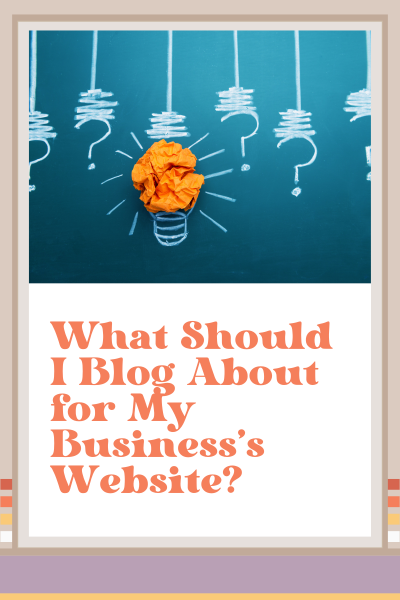What Should I Blog About for My Business’s Website?
If you’ve ever opened a blank page and thought, “What should I blog about?”—you’re not alone. Most business owners know they should be blogging, but they’re not sure what to say, who they’re talking to, or how it’s all supposed to help their business.
The truth? You can’t create blog content with any real purpose until you have one thing figured out first: your brand message.
Below, I’ll explain how your brand message helps you decide what to blog about, what kinds of topics belong on your site, and how to make sure your blog is attracting the right audience.
You Can’t Write Blog Posts (or Website Copy) Without a Brand Message
A brand message is a clear, concise statement that explains who you help, what problem you solve, and why it matters. It’s the foundation for everything you create in your business, including your blog.
Blogging without a brand message is like driving without a destination. You’ll end up somewhere—but probably not where you want to be.
Your brand message clarifies:
Who your audience is
What problem you help them solve
How you help them win
Without that direction, your blog will be scattered and ineffective. You might get traffic—but not from the people who actually need what you offer. That’s a lot of time spent writing content that doesn’t move the needle.
FAQ
Q1: Can’t I just write about topics I find interesting?
A1: Sure, but if they don’t tie into your brand message or the services you offer, they won’t help your business grow. Your blog should support your business goals.
Q2: What about blogging on topics that are interesting to my audience but don’t relate to what I sell?
A2: It’s tempting to chase traffic with popular content, but if those readers aren’t aligned with your offers, it’s unlikely they’ll convert. Your blog is a marketing tool—not a magazine. Focus on content that supports your message and moves your audience closer to working with you.
Your Brand Message Tells You How to Talk to Your Audience
Your brand message doesn’t just help you write—it tells you how to frame every part of your story. It keeps your customer at the center of the narrative, always positioning them as the hero, and you as the guide who helps them succeed.
When you're clear on your message, you're clear on what matters to your audience and how to connect the dots between their problems and your solutions. That clarity makes your blog easier to write and more valuable to the people reading it.
If your brand message is clear, your blog will:
Keep your content focused on your reader’s journey
Connect each post to a larger business goal
Stay consistent with your website and the rest of your marketing
When every post supports the same core story, you create a more cohesive, trustworthy presence that makes it easier for your audience to understand how you can help them.
FAQ
Q1: What if I have different types of customers?
A1: You can create variations of your brand message for each offer or audience, but they should all support your core narrative. The central story of your business should stay the same.
Q2: What if I’m not sure who the "hero" of my brand story is?
A2: That’s a sign it’s time to revisit your brand message. If your content talks more about your business than your audience, it’s probably missing the mark.
What Should I Blog About? Start with Problems You Solve
If you’re asking what should I blog about, the answer lies in your brand message. Your message highlights the problems your audience faces and how your business helps solve them. That’s your content strategy.
Each blog post should:
Solve one small part of a larger problem your offer addresses
Anticipate questions your ideal audience is already asking
Point toward the transformation your business provides
This is how you build trust before someone ever clicks “book now.”
FAQ
Q1: How do I decide what to blog about if I have multiple offers?
A1: Choose one core offer to focus on first, then plan blog content that supports it. You can rotate between offers, as long as every post still aligns with your brand message.
Q2: Should I define my blog categories before I start writing?
A2: Yes. Setting your categories first helps you stay within the guardrails of your business and ensures all of your content supports your message. It’s much easier to stay focused and consistent when you know exactly what topics you’re committed to covering.
How to Decide What to Blog About (and Attract the Right Audience)
Blogging is still one of the best ways to show up in search and get discovered by new people. But if your content is vague, irrelevant, or misaligned with your business—it won’t bring in the right traffic.
A clear brand message ensures your blog is working for you, not against you.
With the right message, your blog will:
Use keywords that make sense for your offers
Speak directly to your target audience
Make it obvious what you do and who you help
This isn’t just about getting traffic. It’s about getting the right traffic—the kind that turns into inquiries, sales, and long-term relationships.
FAQ
Q1: How do I know if my blog is attracting the right people?
A1: Check your content against your brand message. Are you solving the right problems? Are you talking to the right people? Are you pointing them toward the next step in working with you?
Q2: Should I include lead generators in my blog posts?
A2: Yes—if they’re relevant. A blog post is a great place to offer a free resource that solves a small part of the problem you’re discussing. Make sure your lead magnet is closely connected to the post content and speaks to the same audience your brand message is targeting.
Key Takeaways
Before you worry about what to blog about or how to make your blog more consistent, stop and ask: Have I written a brand message for my business? Because once that’s in place, everything else becomes easier.
If you need help building yours, check out my blog post on how to use your brand message to guide your content.
You’ll also find free resources there to help you get started.
This page contains affiliate links
Like this post?












